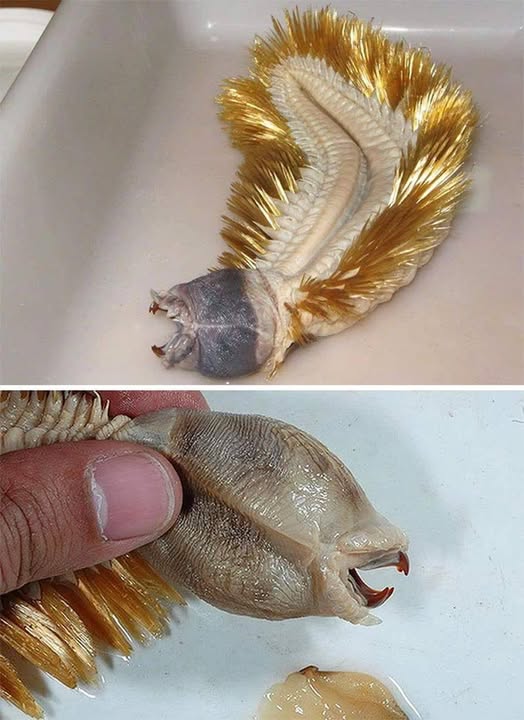Deep beneath the icy waters of Antarctica lives a creature so bizarre that it seems more at home in a horror movie than in the natural world. Meet Eulagisca gigantea — a golden-bristled marine worm with a mouth full of razor-sharp teeth and a body that shimmers like metal under the light.
Recently, this terrifyingly beautiful worm has gone viral online after new high-resolution photos revealed its eerie, alien-like appearance. The images quickly spread across social media, sparking both fascination and fear. People couldn’t decide whether to marvel at its uniqueness or have nightmares about it.
But despite its sudden fame, Eulagisca gigantea is not a new discovery. It was first identified by scientists in 1939, though it remained largely unknown outside the scientific community. For decades, the harsh, icy waters of the Southern Ocean kept this mysterious worm hidden from human eyes.
Only recently, thanks to deep-sea exploration and advanced underwater cameras, have we truly seen what it looks like — and the sight is unforgettable. Its golden, feathery bristles glint like armor, and when its mouth opens, a set of serrated teeth emerge, ready to snatch unsuspecting prey.
This worm can grow up to 8 inches long — about the size of a banana — and possesses one of the most unusual feeding mechanisms in the ocean. Its throat can extend outward like a tube, revealing rows of sharp, fang-like structures used to grasp and consume smaller marine creatures.
Unlike the soft, simple worms we imagine wriggling in soil, this Antarctic predator is a skilled hunter. It uses its expandable mouth to ambush prey in the freezing dark, showing that survival in such extreme conditions demands both beauty and brutality.
Scientists believe its golden bristles serve more than aesthetic purposes. They might help it crawl across the seafloor, sense movement, or even deter predators by reflecting light in dazzling flashes. Each bristle, when examined under a microscope, reveals an intricate structure designed for protection and precision.
Eulagisca gigantea belongs to a group of marine worms known as polychaetes — segmented worms that inhabit nearly every ocean on Earth. There are over 8,000 documented species of polychaetes, though experts believe thousands more remain undiscovered in the unexplored depths.
These worms are critical to the marine ecosystem. They recycle nutrients, break down organic waste, and serve as food for fish and crustaceans. In short, they help keep the ocean alive and balanced, even if some of them, like Eulagisca gigantea, look terrifying.
The viral sensation began when a photo of the worm surfaced on Facebook, showing its metallic body and gaping jaws. The post exploded, with viewers expressing everything from admiration to disgust. Some compared it to creatures from Alien, while others called it “the ocean’s golden monster.”
Despite the shock factor, marine biologists are thrilled by the attention. “Every time the public becomes fascinated by deep-sea life,” one researcher noted, “it’s an opportunity to talk about the beauty and importance of our oceans.”
Indeed, this Antarctic worm reminds us that the ocean still holds countless secrets. Its very existence challenges our understanding of how life adapts to cold, dark, and nutrient-poor environments — places we once thought were uninhabitable.
Explorers now use remotely operated vehicles (ROVs) and submersibles to study such creatures in their natural habitats. These technologies have opened a new frontier beneath the waves, revealing species that blur the line between science and science fiction.
For scientists, Eulagisca gigantea represents not fear, but fascination — proof that evolution creates forms both functional and otherworldly. Each scale and bristle tells a story of adaptation and survival under crushing pressures and freezing temperatures.
The worm’s teeth, so horrifying to us, are actually a marvel of design. Made from chitin — the same material found in crab shells — they’re perfectly adapted for gripping slippery prey in the pitch-black abyss.
As climate change and human activity threaten the fragile Antarctic ecosystem, researchers warn that many such species could disappear before we even learn their names. The golden worm’s fame serves as a timely reminder of what’s at stake beneath melting ice and deepening seas.
To marine biologists, every discovery like this one is a reason to protect rather than fear the unknown. “When people see this worm and say it looks like a monster,” one expert said, “I tell them — yes, but it’s our monster. It’s part of Earth’s story.”
The golden glow of Eulagisca gigantea isn’t just a scientific curiosity — it’s a symbol of nature’s endless creativity. Beneath the frozen Antarctic surface, it thrives where few others can, a reminder that life always finds a way.
From its shimmering armor to its nightmare jaws, this worm embodies the mystery and majesty of the ocean’s hidden world. What may look monstrous to us is, in truth, a masterpiece of survival.
So next time you scroll past its image online, remember — it’s not a creature from another planet. It’s from ours. It’s proof that even in the coldest, darkest corners of Earth, beauty still burns bright.
And in its golden glow, Eulagisca gigantea reminds humanity just how little we truly know about the world beneath the waves — and how much wonder still waits to be found.
